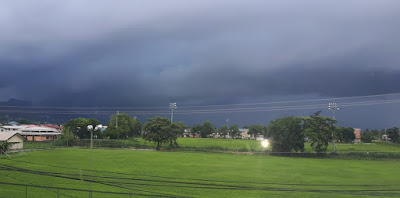Flooding in Trinidad and Tobago
This week we divert our attention away from our wildlife to talk about the major flooding events that occurred within the last five weeks.
What
flooding events have occurred?
There is
no hiding the fact that the Caribbean has entered the Rainy Season. From June
to November every year the Rainy Season results in tremendous flooding across
many parts of Trinidad and Tobago. The first major event of the Rainy Season
was Tropical Storm Elsa, which developed into a Category 1 Hurricane after
passing Trinidad and Tobago. On July 2nd, 2021, Tropical Storm Elsa
approached our shores bringing with it torrential rain and gusty winds causing
flooding and landslides across the nation.
Another, more catastrophic event occurred in North-west Trinidad on August 3rd, 2021. Heavy rains on the mountainous Northern Range of Trinidad (specifically the North-west), triggered large volumes of water to come rushing into the Capital, Port of Spain. The rivers, unable to contain the flow, burst its banks in many areas causing some streets to become ravines as the water had nowhere else to go. There have been many reports of vehicles being washed away and many homes and businesses facing water damage.
 |
| Figure 1: Showing flooding on Saddle Road, Maraval (2021) |
Why did
it flood?
There are
many factors to consider when we discuss flooding. These include: the tide, the
amount of rainfall, lack of drainage, and obstruction of waterways.
Firstly,
the oceanic tide is one of the natural factors that affect flooding. When tides
are high, there is less space for the rainwater to run off therefore causing a
backup in the rivers resulting in flooding.
Secondly,
if there is too much rainfall in a short space of time, the waterways may not
be able to contain such a large volume of water also resulting in flooding.
This is another natural factor that is inevitable since it is dependent on the
weather. The water will take the path of least resistance thereby flooding
cities.
 |
| Figure 2: Showing the Maraval River bursting its banks (2021) |
Thirdly, the lack of drainage especially in urban areas can also result in flooding. The lack of vegetation in these concrete jungles means that rainwater is not being absorbed into the earth and the rate of flow of the surface runoff is faster due to smooth roads. The increase in water means that there must be sufficient drainage within urban areas to alleviate this rapid influx. Without the proper urban planning with regards to drainage, flooding is inescapable.
Lastly, obstruction
of waterways is the number 1 issue when it comes to flooding in Trinidad and
Tobago. From the footage of the flooding that occurred on Tuesday 3rd
August 2021, there was an astonishing amount of debris in the floodwaters.
Garbage bags, plastic bottles, fast food containers (even though fast food
restaurants only reopened two weeks ago), appliances are all examples of the
waste we put into our rivers and cause the city to be inundated. The improper
disposal of domestic waste continues to be an issue in Trinidad and Tobago.
What can
we do to alleviate flooding?
On an
individual level, everyone can make a concerted effort to avoid putting waste
into the waterways. This will significantly reduce the obstruction of water
flow thereby allowing the water to be released faster. On a national level, the
government of Trinidad and Tobago could analyse the areas that flood the most
and determine what action can be taken to prevent flooding such as cleaning,
widening or deepening exercises in rivers, providing appropriate waste
collection sites, or re-evaluating if people should live in areas that act as
natural basins or watersheds. There is also a more long-term solution that will
require major restructuring of our cities, but it can be substantially
beneficial. It is called sponge cities. These cities have porous layers that
allow rainwater to be collected and stored in underground tanks to be released
gradually when water levels decline. It is indeed a monumental project, but it
can save thousands of dollars in damages every year.
What more can we do to prepare for the next Rainy Season? Drop your ideas in the comments below.
 |
| Figure 4: Showing gloomy weather (2021) |
References
"Elsa Brings Flood To T&T".
2021. Trinidad Express Newspapers.
https://trinidadexpress.com/news/local/elsa-brings-flood-to-t-t/article_3c65cc1a-db95-11eb-8b0c-9778d946a5ed.html.
"Water". 2021. Mdpi.Com.
https://www.mdpi.com/journal/water/special_issues/Sponge-Cities#:~:text=A%20Sponge%20City%20is%20a,urban%20planning%20policies%20and%20designs.&text=City%20governments%20at%20all%20institutional,industrial%20parks%20and%20development%20zones.



Comments
Post a Comment